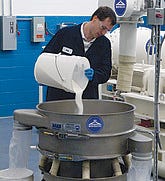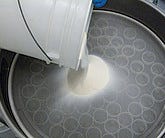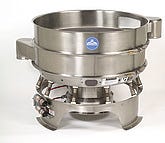October 19, 2010
|
An operator pours xanthan gum into a vibratory round separator for screening of the material. |
By Jeff Dierig, Sweco
Xanthan gum is a distinctive material most commonly found in food additives, but it can also be found in various cosmetics and industrial products as well. It is derived from the starches of extracted corn kernels. The starches are processed to form sugar, which is mixed with Xanthomonas campestris (a bacterial microorganism) and fermented. The fermented blend is then dried, ground to a fine powder, and screened before final processing and packaging.
Xanthan gum has many applications in the food industry such as its use in dairy products and salad dressings as a thickening agent and stabilizer, as a substitute for wheat gluten in various gluten-free food-products, in ice creams to prevent ice crystals from forming, and it adds texture to low or no-fat dairy products. In the cosmetics industry, xanthan gum is used by manufacturers as a stabilization and binding agent to keep the ingredients from separating in their products. The oil industry also makes use of xanthan gum by using it as a thickening agent to produce a water-based fluid used in the drill parts lubrication process. These are simply a few examples, and to say the least, there are more uses for xanthan gum than can easily be described.
For manufacturers of xanthan gum, the challenge hasn’t always been finding where the product can be utilized, but finding the most economical way to produce a quality product. One of the most difficult stages of production has been in the screening process, attempting to separate the fine ground powder by micron size.
|
Xanthan gum being poured directly onto the screener (not in motion). |
Segregating the powder by size poses a challenge for two main reasons. One, a typical xanthan gum process requires a separation point of around 75 micron. Anyone experienced in screening processes is aware that screening fine material in a dry process can be extremely difficult to accomplish. This is mostly due to the fact that vibratory screening is accomplished mostly by gravity, and forces such as static and friction sometime work against gravity when dealing with smaller particles, making it very difficult for the material to fall through the screen.
|
Close up of the xanthan gum and its movement on the screen while the separator is running. |
The second reason why the screening process is a major challenge for xanthan gum manufacturers is because the powder can be a very sticky substance with a tendency to agglomerate, making the product difficult to go through the screen. If any moisture (even from the air’s humidity) gets into the powder, it tends to gel into a slimy, viscous material, making it very difficult to screen. Most manufacturers typically screen the product in a controlled environment to prevent moisture from getting into the powder.
A manufacturers’ objective when screening xanthan gum is to efficiently and effectively separate as much of the powder as possible as to not make the screening process the bottleneck of the operation. However, if too much material is fed to the separator they run the chance of having an inefficient separation, ultimately wasting good product. So, simply dumping more material into the separator in hopes of gaining throughput is not a viable solution.
|
Image of a typical vibratory round separator, the type of machine xanthan gum manufacturers use to screen their product. |
There are two factors that manufacturers need to consider to help generate a higher output of xanthan gum. First, by utilizing a high-speed motor, producers can increase the frequency and transmit more energy into the product on the screen, utilizing the motion of the separator to help break up any agglomerations and facilitate the product in going through the screen more efficiently. The second matter manufactures need to consider is the use of some type of self-cleaning device for the screens to assist in keeping the screen mesh clear of obstructions and near-size particles. There are several options that can be considered when dealing with self-cleaning devices. Self-cleaning screens (comprised of a working mesh on top of the tension ring with a coarser mesh attached to the bottom of the ring with sliders and/or balls placed between the meshes) and self-cleaning kits (comprised of a perforated plate below the working mesh with sliders and/or balls placed between the mesh and plate) are two of the most common choices. In both of these devices, the sliders and balls will bounce off of the support screen or perforated plate and tap the top screen dislodging near size particles or fibers that tend to blind the screen and reduce screening area. Another option to consider would be ultrasonic devices. Ultrasonic devices promote improved excitation throughout the screen surface with more even energy distribution, improving sieving efficiency, separation accuracy, and effectively breaking up agglomerates while increasing throughput. Unfortunately, ultrasonic devices do not always work on every application. Testing is always a good idea when there is uncertainty.
Finding the right combination of self-cleaning devices and separator motion is critical in successfully screening xanthan gum or any dry powder for that matter. One particular manufacturer was able to increase their throughput of xanthan gum by 134% simply by choosing the correct combination. Of course each process is different due to all of the factors that must be considered, and results will certainly vary from plant to plant and application to application. But if manufacturers can find the combination that works best for their process, success can be just around the corner.
Jeff Dierig is the global marketing manager for Sweco (Florence, KY), a manufacturer of industrial screens, and classifying and sifting equipment. For more information visit www.sweco.com
You May Also Like






